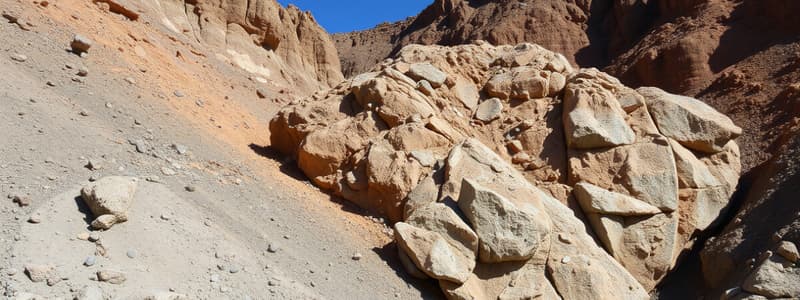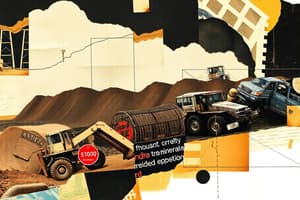Podcast
Questions and Answers
What is the main process through which ore minerals are deposited from hydrothermal fluids?
What is the main process through which ore minerals are deposited from hydrothermal fluids?
- Chemical alteration and recrystallization (correct)
- Selective sifting of sediments
- Sedimentation from groundwater
- Evaporation and crystallization
Placer deposits are formed by the selective sifting of smaller sediments, leaving behind heavier materials.
Placer deposits are formed by the selective sifting of smaller sediments, leaving behind heavier materials.
False (B)
What is the largest ocean on Earth?
What is the largest ocean on Earth?
- Pacific Ocean (correct)
- Arctic Ocean
- Atlantic Ocean
- Indian Ocean
What are the three common types of ore minerals mentioned in the content?
What are the three common types of ore minerals mentioned in the content?
Salinity refers to the measure of saltiness in saltwater.
Salinity refers to the measure of saltiness in saltwater.
The process that can create evaporate deposits from saltwater minerals is known as __________.
The process that can create evaporate deposits from saltwater minerals is known as __________.
Match the following types of mineral deposits with their formation process:
Match the following types of mineral deposits with their formation process:
Name the world's largest glacier.
Name the world's largest glacier.
The freshwater stored in glaciers and ice sheets is estimated to exceed _____ km³.
The freshwater stored in glaciers and ice sheets is estimated to exceed _____ km³.
Match the following glaciers with their characteristics:
Match the following glaciers with their characteristics:
Which of these factors makes seawater less salty?
Which of these factors makes seawater less salty?
Most of the freshwater on Earth is easily accessible in rivers and lakes.
Most of the freshwater on Earth is easily accessible in rivers and lakes.
What percentage of stored freshwater is concentrated in Antarctica?
What percentage of stored freshwater is concentrated in Antarctica?
What is the definition of permafrost?
What is the definition of permafrost?
Groundwater makes up about 50% of the total freshwater on the planet.
Groundwater makes up about 50% of the total freshwater on the planet.
What are the types of surface water reservoirs?
What are the types of surface water reservoirs?
An __________ is a region where water covers the land for significant periods.
An __________ is a region where water covers the land for significant periods.
Match the following bodies of water with their characteristics:
Match the following bodies of water with their characteristics:
How does evaporation affect surface water reservoirs?
How does evaporation affect surface water reservoirs?
Aquifers hold subsurface water and are important for freshwater supply.
Aquifers hold subsurface water and are important for freshwater supply.
Freshwater is not __________ equally across the globe.
Freshwater is not __________ equally across the globe.
What percentage of the world's population does Canada represent in terms of liquid freshwater availability?
What percentage of the world's population does Canada represent in terms of liquid freshwater availability?
Thermal desalination is a process that adds salt to freshwater.
Thermal desalination is a process that adds salt to freshwater.
What is the major receipt in the water budget?
What is the major receipt in the water budget?
The largest portion of freshwater today is located in _____
The largest portion of freshwater today is located in _____
Which human activity is NOT associated with improving water quality?
Which human activity is NOT associated with improving water quality?
Match the following human activities to their potential impact on water quality:
Match the following human activities to their potential impact on water quality:
Wetlands are an important source of groundwater recharge.
Wetlands are an important source of groundwater recharge.
In the context of freshwater withdrawals, the term 'Domestic' refers to activities such as _____
In the context of freshwater withdrawals, the term 'Domestic' refers to activities such as _____
What is the main consequence of groundwater mining?
What is the main consequence of groundwater mining?
Soft water has a high mineral content, primarily consisting of Ca2+ and Mg2+.
Soft water has a high mineral content, primarily consisting of Ca2+ and Mg2+.
What does the presence of fecal coliforms in water indicate?
What does the presence of fecal coliforms in water indicate?
The ideal pH range for drinking water is between _____ and _____.
The ideal pH range for drinking water is between _____ and _____.
Match the following contaminants with their associated sources:
Match the following contaminants with their associated sources:
Flashcards are hidden until you start studying
Study Notes
Ore Minerals
- Ore minerals are naturally occurring solid materials from which metals or valuable minerals can be profitably extracted, such as gold, iron, and copper.
- The extraction process involves a combination of mining, refining, and processing to separate the valuable minerals from the ore.
Chemical Composition
- The chemical composition and the percentage of extractable resources determine the profitability of an ore.
- Market value depends on demand and resource availability.
Ore Mineral Deposition Processes
- Hydrothermal deposits form when groundwater or seawater is heated by magma, leading to mineral vein formation that hosts metals like gold and silver.
- Evaporate deposits result from the precipitation of saltwater minerals (e.g., halite, gypsum) and the evaporation of lake water.
Placer Deposits
- Wave action can cause selective sifting, leading to the concentration of heavier sediments in placer deposits.
- These deposits are significant sources of minerals, influenced by environmental conditions.
Groundwater and Aquifers
- Groundwater, which constitutes about 30.1% of global freshwater, accumulates in aquifers composed of porous rock.
- Groundwater volume is approximately 40 times larger than surface water and is critical for agriculture and domestic use.
Surface and Freshwater Reservoirs
- Surface water reservoirs include various bodies of water like streams, rivers, lakes, and wetlands, essential for the hydrologic cycle.
- The total surface freshwater primarily resides in glaciers and ice sheets, covering 15 million km².
Oceans and Saltwater Reservoirs
- Oceans cover 71% of Earth’s surface and are divided into five major basins by size; the Pacific Ocean being the largest.
- Salt concentration in oceans is affected by evaporation and precipitation, influencing marine ecosystems.
Water Scarcity and Desalination
- Freshwater withdrawals for agriculture, industry, and domestic use reflect the growing pressure on available water resources.
- Thermal desalination is a process for extracting freshwater from saltwater, critical in water-scarce areas.
Effects of Human Activities
- Human activities such as land conversion, agricultural runoff, and industrial operations impact water quality and availability.
- Contaminants include untreated sewage, agricultural pesticides, and leakage of harmful chemicals.
Groundwater Mining
- Over-extraction of groundwater leads to lower water tables, droughts, and land subsidence, emphasizing sustainable management practices.
Water Quality Testing
- Water quality is assessed through physical tests (pH, temperature, turbidity), chemical analysis (total dissolved solids, nitrates), and bacteriological analysis (coliform presence).
- Hard water contains high mineral content (Ca²⁺ & Mg²⁺), while soft water has low mineral content.
Key Lakes and Wetlands
- Notable lakes include the Caspian Sea (world's largest) and Lake Baikal (world's deepest).
- Wetlands cover 8.5% of the land surface and are vital for biodiversity and water quality management.
Studying That Suits You
Use AI to generate personalized quizzes and flashcards to suit your learning preferences.




